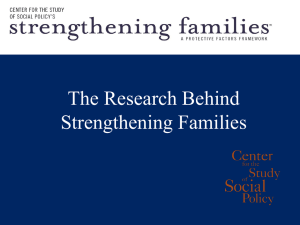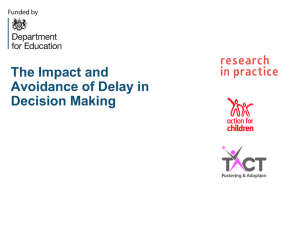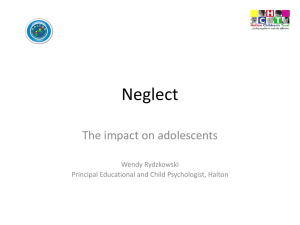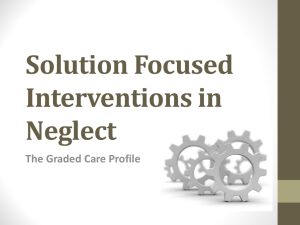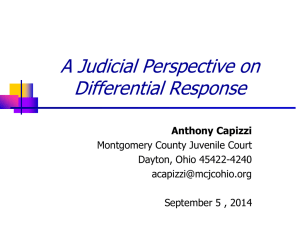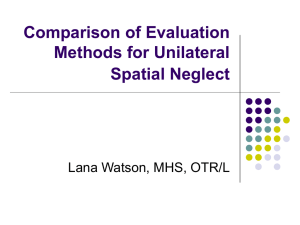Lynn McDonald`s Presentation Slides
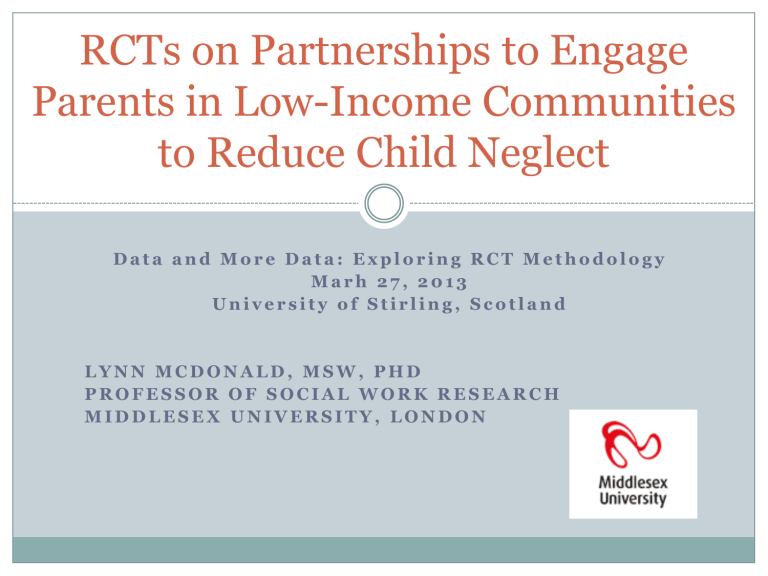
RCTs on Partnerships to Engage
Parents in Low-Income Communities to Reduce Child Neglect
D a t a a n d M o r e D a t a : E x p l o r i n g R C T M e t h o d o l o g y
M a r h 2 7 , 2 0 1 3
U n i v e r s i t y o f S t i r l i n g , S c o t l a n d
L Y N N M C D O N A L D , M S W , P H D
P R O F E S S O R O F S O C I A L W O R K R E S E A R C H
M I D D L E S E X U N I V E R S I T Y , L O N D O N
An Evidenced Based Parenting
Programme by a Social Work Academic
2
Specify a social problem; look for basic research and relevant theories from social sciences; create social interventions which can move Theories into practice and apply social research with vulnerable populations; consider multi-family groups; conduct qualitative research and feedback loops from service users and practitioners; test promising social work approaches with randomized controlled trials in distinct disadvantaged communities. Build quality assurance structures for replication and assess continuously with service user feedback.
A Social Problem: Child Neglect
Half of safeguarding referrals are for neglect
Stressed and isolated families have higher risk of both abusing and neglecting a child
Child neglect causes impaired learning, poor health, increased aggression and teenage pregnancy (5x higher than no neglect)
Children in poverty at more risk of neglect:
If family lives <$15,000 versus >$30,000,
44 times more likely the child is neglected
ACE Correlates with Adult Health
ACE (Adverse Child Events) retrospective data from
3353 women (aged 47) on reports of child neglect & abuse
Correlated with increased health problems as adults
Substance abuse, depression, suicide, eating disorders, anxiety
Physical health: cardiovascular, cancer, stroke, hypertension
Medical service utilization high for adults with ACE
Emergency rooms, outpatient hospital, pharmacy, primary care, specialty care
Risk and Protective Factors of Child Neglect
Protective factors:
For Child: quality of parent-child bond
For Child: one caring relationship over time to turn to when stressed
For Parent: social network of support; social capital; extended family
For Parent: feeling self-efficacious; empowered voice and agency
Risk factors
Child neglect: no provision of shelter, food, and emotional bonds
Family has chronic stress, conflict, violence, substance abuse, depression, mental health problems
Family is socially isolated from extended family, friends, neighbors
Family experiences social exclusion, racism, health disparities
Parents are oppressed, no control over own life, no respect, no voice
Poverty, lack of housing, employment, education, health services
High Stress Effects a Child ’s Development
Stress changes the brain and alters chemical neurotransmitters related to violence
Stress changes gene expression of child
Neglect/abuse correlates with high sustained stress (cortisol) = damaging to child ’ s brain
High stress causes low immune systems and children get sick more often and heal slowly
High stress puts child into survival mode, and stressed children cannot learn new things: academics, mathematic, reading or writing
Caring Relationships Can Buffer the Impact of High Stress on a Child ’s Development
Sustained high stress (cortisol) levels are destructive to a child ’s brain development and other organs
15 minutes of one to one responsive play reduces stress
High stress levels can be managed with a responsive parent who shows their love and
Notices child ’s emotions and is tuned in to the child
Is available to the child under stress
Asks questions and listens
Is physically soothing and touches the child
Plays responsively with no bossing, and follows the child ’s lead
(Sue Gerhardt, 2002,Why Love Matters)
High Stress Diverts Parental Focus on Child
Cannot focus on child’s needs; not emotionally intellectually
Not enough time, no time for seeing friends/family for support
Use of computers, mobile phones, TV divert focus from child
Work and transport to work; employment insecurity, food insecurity, residential instability, chronic stresses of poverty
Fear of inadequate medical and dental care, support services
Trapped in a dangerous neighbourhood
Trapped in a dangerous relationship
Daily experience of stigma and social exclusion, racism
Feelings of helplessness, hopelessness, low sense of agency
Low hope and mood, low patience, irritability, distracted, anxious
Court ordered Daily In Home Visits (3 mo)
To try to reduce placement of 0-5 child abuse and neglect cases into foster care: daily visits for three months to the home and 2x weekly intensive family therapy sessions: reduced 55% with Safe at Home
Daily coaching of one to one responsive play by a trained assistant;
first listen to the parent for 15 minutes;
then coach the parent for 15 minutes
Dramatic increase in child well-being; often a distressed parent swings from neglect to abuse
Court Ordered Parenting Classes, Groups
In US, 1 million reports of child neglect and abuse annually; 2/3 are substantiated
448,000 parents ordered to attend parenting classes
Parenting problems of caregivers are 1 in 12 about excessive discipline; neglect is over 50% of cases
Parenting programmes generally over-focus on control alternatives to reduce excessive discipline
Agencies prefer brief, low cost groups, linear ideas
Most programmes are untested with little evidence
Parenting Skills vs Stress of Social Isolation
A classic study was conducted on court ordered behavior modification parenting groups referred by the child protection workers for child abuse/neglect
Prof Robert Wahler taught behavior modification techniques with success in parenting knowledge
Six months later he assessed their use of new skills
If they had no friends or positive extended family social support, i.e. socially isolated, they did not use the parenting skills they had learned (insular parent)
Social capital and Stress and Child Neglect
Chronic stress and social isolation increase child neglect: stresses of poverty, social exclusion reduce parents’ ability to be responsive and parent positively
Social capital
Reduces
Stress
Reduces Child
Neglect
Social capital reduces stress o Social ties and inclusion buffer stress and enhances adults’ coping mechanisms leading to better mental health, less irritability & anger
Neurons Connected by Life
Experiences: Synapses & Dendrites
13
Neural Networks form with
Repetition & Emotional Intensity
14
Sculpting: Neurological Pruning of Non-connected Neurons
15
Home Environment: Words Heard by Child
Words heard by hour week year
Low income 616 62,000 3 million
Working class 1251 125,000 6 million
Professional 2153 215,000 11 million
What you hear, how you talk, how you read and write
Ages of Neurological Pruning
17
Ages of Neurological Pruning
18
Apply Social Work Values and Skills
Social work values of respect and shifting power
Service user involvement in partnership with professionals
Multi-systemic. social ecological, local contextual interventions
Anti-oppressive and anti-discriminatory practice
Social work focus on quality of relationships
Between individuals, parent-child bonds, within families,
Lead groups of professionals in multi-agency working
With socially marginalized, low income parents: social inclusion
Social work systemic strategies to build relationships
Social cohesion, social trust, networking and social inclusion
Coleman, 1988: ‘intergenerational closure in schools’
Families and Schools Together (FAST)
Universal voluntary parenting programme for all age
4-5 children living in disadvantaged communities
Focus on relationships, social capital and protective factors, as all parents have stress sometimes
Support all parents in practicing positive parenting
Transition into school for all 4-5 year olds with FAST
If a parent comes once to FAST, 80% return for 8 weekly sessions & 22 monthly multi-family meetings
86% of FAST parent graduates report having made a friend they see years later; reduce stress & isolation
Parents Co-Produce FAST as
Prevention of Neglect
Respect for parent role and knowledge at every level of the FAST programme: ‘ nothing about us without us ’
Parents participate in training and planning FAST: coproduction with multi-agency professionals: 60% flexible
Parents are on multi-agency FAST team leading groups
Parents are coached to be in charge of their own family
Parents are given time to form informal social networks
22
FAST Groups Build Protective
Factors Against Child Neglect
Strengthen family unit
Parent-child bond
Parent-to-parent bond
Parent group
Parent and community
Parent and school
Ten theories into practice in FAST
Parent groups are built on Paulo Friere’s ideas of adult education groups in low income communities
Minuchin family systems theory empower executive subsystem, increase engagement, reduce conflict
Family stress theory (Hill; Boss) hope; social support
Attachment theory (Bowlby) into practice (Kogan)
Parents ask children to do small tasks as imbedded compliance requests (social learning theory)
Systematically reinforce attendance (learning theory)
Family school and community (social ecology theory)
Social ecological theory of child development (Bronfenbrenner)
C H I L D
NICHD Social Capital FAST Project
Social ecological theory of child development (Bronfenbrenner)
C H I L D family
NICHD Social Capital FAST Project
Social ecological theory of child development (Bronfenbrenner)
C H I L D family school
NICHD Social Capital FAST Project
Social ecological theory of child development (Bronfenbrenner)
C H I L D family school neighborhood
NICHD Social Capital FAST Project
Social ecological theory of child development (Bronfenbrenner)
C H I L D family school neighborhood
Experiential learning through parent led repeated activities (no “ teaching ” or lecturing)
Family Scribbles Game
Family Flag
Feeling Charades
Parent-child bonds built in play activity and rehearsals of parental responsiveness to child
Special Play
Building Social Capital through Schools
Every child goes to school; invite whole families
James Coleman sociologist Univ of Chicago studied schools and developed a theory of social capital
Children get to know one another at school
Children know their parents at home
If parents become friends with their children’s school friends, that is ’ intergenerational closure’, a powerful form of social capital
If the average parent at a school knows 4-5 other parents, that school has high social capital
FAST builds intergenerational closure at schools
Partnership
+ + +
+
+
+
+
+
+
+
Randomised controlled trials on FAST
Collaborations with other researchers from medicine, public health, sociology, psychology, who were interested in impact of a social intervention
5 RCTs on FAST completed with low income families
Abt Associates, (2001); Kratochwill, et al, (2004); McDonald et al, (2006), Kratochwill et al.(2009), Gamoran & Turley (2013)
Funding from NIH (NIDA, NICHD), SAMHSA, DOJ, DOE
Positive child behavioural and mental health (SDQ) outcomes over 1 and 2 years, across domains of child social ecology (child, family, school, community)
Randomized Controlled Trial:
Can FAST Build Social Capital
R u t h N . L ó p e z Tu r l e y, R i c e U n i v e r s i t y
A d a m G a m o r a n , A l y n Tu r n e r, a n d R a c h e l F i s h
U n i v e r s i t y o f W i s c o n s i n - M a d i s o n
This research was supported by NICHD grant no. R01HD051762-01A2. Its contents are the responsibility of the authors and do not necessarily represent the official views of the supporting agency.
Social Capital
By “social capital,” we mean relations of trust, mutual expectations, and shared values embedded in social networks
The paper addresses conceptual as well as causal ambiguity
This presentation focuses on causal inference
An Intervention Approach to
Addressing Causal Ambiguity
Random assignment is the best way to sort out causal ambiguity
We cannot randomly assign families to social capital
Instead we randomly assign schools to a socialcapital-building intervention
We test whether school assignment to the intervention boosts social capital for families
The Intervention
Families and Schools Together (FAST)
research-based after-school program
universally recruited 1 st grade families
8 weeks of weekly meetings at schools
2 years of monthly meetings
designed to strengthen bonds
parents and school staff
parents and other parents
parents and children
Social
Capital
FAST
Research Design
Phoenix San Antonio
Control
Data
Demographic characteristics of the child and the child ’s parents
Pre-FAST measures of social capital
School characteristics
Parent-parent network social capital
Child socio-emotional and problem behaviors reported by 1 st grade teachers
Statistical Methods
FAST as an indicator of social capital
Intent to Treat: Two-Level Model
Treatment on the Treated: Two-Level Complier Average
Causal Effect Model
Intervention
Outcomes
FAST graduates compared
47
Across 26 schools, on average 44 families attended at least one FAST session
Across 26 randomly assigned control schools, there were no FAST sessions
Of the families who completed FAST (5 sessions), characteristics were collated
In the control schools, a comparable group was created with similar characteristics
Methods
Treatment on the treated
(TOT)
COMPLIERS
WOULD BE
COMPLIERS
NON-COMPLIERS
WOULD BE
NON-COMPLIERS
Intent to treat
(ITT)
FAST Comparison
ITT Effects on Social Capital
Outcome
Intergenerational
Closure
Shared Expectations with Other Parents
Intervention
Social
Capital
49
Effect size Est/S.E.
P-value
0.13
3.02
0.003
0.33
3.28
0.001
49
TOT Effects on Social Capital
Outcome
Intergenerational
Closure
Shared Expectations with Other Parents
Intervention
Effect size Est/S.E.
P-value
0.35
2.83
0.005
0.97
2.93
0.003
Social Capital
50
50
Low Drop Out Rates for Low Income Parents
Retention rates: if a family comes once to FAST, on average 80% will complete 6 or more of 8 weekly FAST meetings & graduate to lead 22 monthly groups;
72% inner city, low income, single parent, African American families with emotionally disturbed children
80% rural, Indian reservations, low-income families with universal recruitment of all children
85% urban, Mexican American immigrants, low income, universal recruitment of all children
90% risk for special education with behavior problems, low-income, mixed cultural backgrounds
However, if a family comes once to a child mental health clinic, 40-60% (Kazdin, 2001) will drop out; if family is low income or socially marginalized > 60% drop out
Effects of FAST- child at home d=.42
Source: Kratochwill et al. (2009) (CBCL Externalizing Scale)
Effects of FAST-family domain
Family adaptability
27
26
25
24
23
22
21
20
23
25
FAST
Source: Kratochwill et al. (2009) (FACES )
26
Control
25
Pre
Post: 8 weeks d=.66
Effects of FAST- school domain
106
104
102
100
Teacher ratings of social skills in classroom
102
104
100
98
96
97
94
FAST
Comparison group
(parenting pamphlets)
Source: McDonald et al. (2006) (using Social Skills Rating Scale-Gresham& Elliot)
Pre
Post: 2 year d=.26
Lists of Evidence Based Practice EBP
UN United Nations Office of Drugs and Crime (2010)
Family skills Programme (FAST is 11 of 23 based on RCTs)
FAST has highest on retention rates of low-income parents
UK National Academy of Parenting Practitioners
Number 7 of parenting programmes for training workforce
US government lists for evidence based practice
Child abuse and neglect prevention
Child mental health promotion
Substance abuse prevention
Juvenile delinquency prevention
Since 2010, 2,268 whole UK families completed 6+ of 8 FAST sessions, graduated to monthly sessions;
77% of the families lived on
Very Low-Incomes
(under £20,000 annually)
18 UK families per FAST; 81% retention;
107 schools in low-income communities
60
50
40
30
20
90
80
70
10
0
Cycle 1 Cycle 3 Cycle 5 Cycle 7 Average
Highest % Parents Reporting on FAST Impact
58
1.Parental self-efficacy which is related to parent empowerment
77% of parents who graduated from FAST reported increased parental self efficacy
2.Parent Child relationship is enhanced; attachment is deepends;
70% of parents reported improvement of this relationship
3. Reciprocal ties in community-mutuality of being helped and of helping others who are raising young children
UK Aggregate of Pre-Post FAST & Cross
Domain Reports of Relationships
Parent-Child Bond increased 11% ****
Family Conflict reduced -22% ****
Family relationships increased 16%****
Parent to parent reciprocity 31% ****
Provide support +28%---Receive support +32%
Parent involvement in school 33% ****
2
0
10
8
6
4
UK Parents Report Changes Pre FAST and Post FAST on Child’s Mental Health at home
Strengths & Difficulties Questionnaire (Goodman, 1997)
14
11,75
12
8,6
7,69
8,17
4
4,44
3,61
8,6
9,35
British Average
Pre FAST
Pro-social
1,9
2,55
1,92
Emotional
1,6
2,36
1,79
1,4
2,38
2,01
Conduct Hyperactivity Peer Problems Total
0,3
0,96 0,82
Impact
Post FAST
=P<.10(10% change due to chance)
=
P<.05 (5% change due to chance)
P<.01 (1% change due to chance)
P<.001 (0.1% change due to chance)
UK Teachers Report Changes Pre and Post FAST on
Child’s Mental Health at School
Strengths & Difficulties Questionnaire (Goodman, 1997)
=P<.10(10% change due to chance)
=
P<.05 (5% change due to chance)
P<.01 (1% change due to chance)
P<.001 (0.1% change due to chance)
Pre Post Child Well-Being
SDQ Statistically Significant Changes****
62
Parent Report Teacher Report
Emotional -20%
Conduct -18%
Hyperactivity -13%
Peer problems -10%
Total problems -15%
Impact -25%
Pro-social +10%
Emotional -20%
Conduct -20%
Hyperactivity -15%
Peer problems -16%
Total problems -17%
Impact -27%
Can FAST Prevent Child Neglect? We Need
More Rigorous Research Data To Prove it.
Child neglect (ACE) prevention can be at a community level
Multi-agency working includes health, education, social care
Health inequalities and education disparities result from stress of poverty, family stress and social isolation, and neglect
Effects of chronic stress from poverty, social isolation and social exclusion of parents increase irritability/child neglect
Service user/carer involvement (and cultural representation) can co-produce local outreach and engagement strategies
Evaluation of impact of social work interventions at local levels improves practice to reduce stress, social exclusion and neglect
Need an RCT on FAST which is community wide with good neglect records over time—time for another partnership
